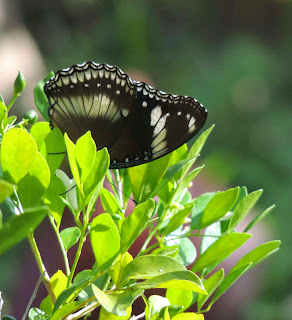The Dusuns have been using pangi (kepayang in Malay) as a food
preservative for generations. I’ve known this nut since childhood because my
mother also used it to make daat—a
fish pickle. Therefore, I was surprised to learn, a few years ago, that the
pangi is poisonous unless prepared in a certain way to rid it of toxins before adding
it to the cooking pot.
In the old days, before the advent of refrigerators, meat
and fish were preserved by salting them before putting them under the sun until
they were bone-dry. They could also be preserved by smoking or by pickling, or
by covering the sliced meat or fish pieces all over with the pounded flesh of
the pangi nuts (Pangium edule) before drying them under the sun.
The nuts come from the pangi tree which grows wild in the
kampungs. Until several years ago, despite living my childhood in the kampung,
I thought the pangi nuts hung from branches just like rambutans or sour limes.
Imagine my surprise when I saw my first pangi pod!
Not many people are aware that the nuts are contained in a
pod because what they see for sale at the tamu are the individual nuts after
their ‘housing’ has been removed and discarded.
The mature pangi tree measures about 50 to 60 feet in
height. Pods hang individually or in clusters on the branches high above the
ground. People tend to mistake the pods for the more familiar bambangan as both
occur in the same shade of brown. However, closer inspection will show that the
skin of the pangi pod is covered with tiny raised spots and it feels rough to
the touch. The bambangan is smoother and unlike the pangi pod, it is rounded.
The pangi looks as though two hands have pulled it by the stalk and lower end resulting
in a shape more longish than round. The pulling has also left a ‘nipple’ on the
lower end. This is absent in the bambangan.
Peeling the skin of the pangi pod, (which falls from the
branch when it matures,) will reveal rows of nuts arranged neatly in tight
rows. The nuts are covered with pale cream-coloured, sweet pith that is stuck
to the nut and is difficult to remove. Cows are fond of the sweet, sticky pith.
They eat it and they swallow the nuts whole and thus help in seed dispersal.
The pictures show a pangi pod with the top half of the peel cut away. Since it was difficult to remove the pith without disturbing the nuts, I left the pod under the sun for several days. The pith dried up slowly to reveal the nuts packed in tight rows.









